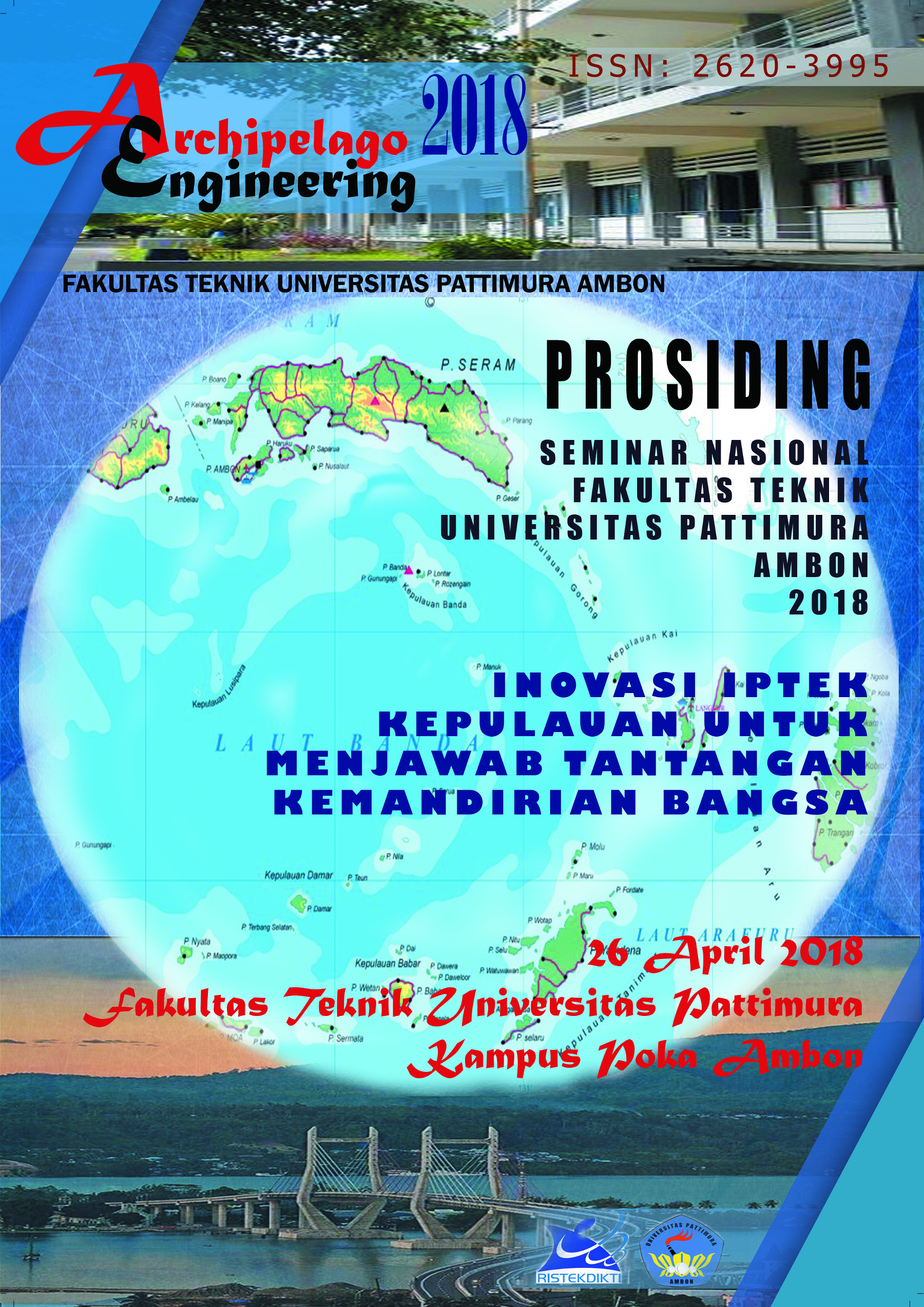PENGARUH VARIASI SELIMUT BETON TERHADAP KAPASITAS BALOK PERSEGI DALAM MENAHAN KECEPATAN KOROSI
Abstract
Abstrak Selimut beton atau concrete ducking atau disebut juga pelindung tulangan cukup penting dan sangat menentukan keamanan dari tulangan pada struktur beton bertulang terutama pada struktur yang berada di lingkungan yang bebas dan agresif. Di Maluku umumnya pembangunan infrastruktur terutama jembatan lebih banyak dibangun dalam jarak < 1 km dari garis pantai. Ini menyebabkan struktur dari jembatan tersebut sangat terpengaruh terhadap agresifitas dari ion klorida penyebab korosi. Hal ini menyebabkan keamanan dan umur struktur akan semakin pendek mungkin saja kurang dari umur rencana. Penelitian ini bertujuan untuk mengetahui sejauh mana pengaruh selimut beton dalam mencegah laju korosi dan juga kapasitas lentur dan geser dari struktur yang di desain sebagai suatu model dengan menggunakan pembebanan dari AASTHO (American Associates of System Transportation and Highway Organization) yaitu AASTHO-LRFD-1998. Kesimpulan dari hasil penelitian, bahwa semakin tebal selimut beton maka semakin baik dalam menahan laju korosi namun semakin kecil kapasitas lentur dan geser yang dihasilkan. Diperoleh juga bahwa faktor air-semen, w/c juga turut mempengaruhi kapasitas lentur dan geser balok. Semakin Kecil Nilai w/c maka semakin tinggi kapasitas lentur dan
geser balok. Penelitian ini masih belum begitu intensif disebabkan belum mengetahui keandalan struktur dalam arti umur layan struktur akibat pengaruh korosi sehingga perlu adanya penelitian yang berkelanjutan.
Downloads
References
Darmawan M.S., (2006), â€Model Korosi untuk Struktur Beton Bertulang di Lingkungan Air Lautâ€, Seminar Nasional Rekayasa Perencanaan VIII 2006, UPN Jatim, Surabaya.
Ferguson P.M., (1981), â€Reinforced Concrete Fundamentalsâ€, SI Version, 4th Edition, Penerbit John Wiley & Sons, Inc., USA.
McCormac Jack C., (2001), â€Design of Reinforced Concreteâ€, John Wiley and Sons, Inc., USA.
Mirza S.A., & MacGregor J.G., (1979), â€Variations in Dimensions of Reinforced Concrete Membersâ€, Journal of Structural Devision, ASCE, Vol. 105, No. ST4, pp. 751-766.
Stewart M.G. & Rosowsky D.V., (1998), â€Structural Safety and Seviceability of Concrete Bridges Subject to Corrosionâ€, Journal of Structural System, ASCE, Vol. 4th, No. 4, pp. 146-155.
Roberth H.H., Raka I.G.P., Darmawan M.S. & Wimbadi I., (2011), †Study on Corrosion Effect of Strength Reinforced Concrete Beams based on Probabilistic Theoryâ€, Seminar Nasional ATPW 2011, ITS, Surabaya.
Vu K.A.T. & Stewart M.G., (2000), â€Structural Reliability of Concrete Bridges Including Improved Chloride-Induced Corossion Modelsâ€, Structural Safety, Vol. 22, No. 4, pp. 313-333.
An author who publishes in the ALE Proceeding agrees to the following terms:
- Author retains the copyright and grants ALE Proceeding the right of first publication of the work simultaneously licensed under the Creative Commons Attribution-ShareAlike 4.0 License that allows others to share the work with an acknowledgment of the work's authorship and initial publication in this journal.
- Author is able to enter into separate, additional contractual arrangements for the non-exclusive distribution of the journal's published version of the work (e.g., post it to an institutional repository or publish it in a book) with the acknowledgment of its initial publication in this journal.
- Author is permitted and encouraged to post his/her work online (e.g., in institutional repositories or on their website) prior to and during the submission process, as it can lead to productive exchanges, as well as earlier and greater citation of the published work (See The Effect of Open Access).
Read more about the Creative Commons Attribution-ShareAlike 4.0 Licence here: https://creativecommons.org/licenses/by-sa/4.0/.






